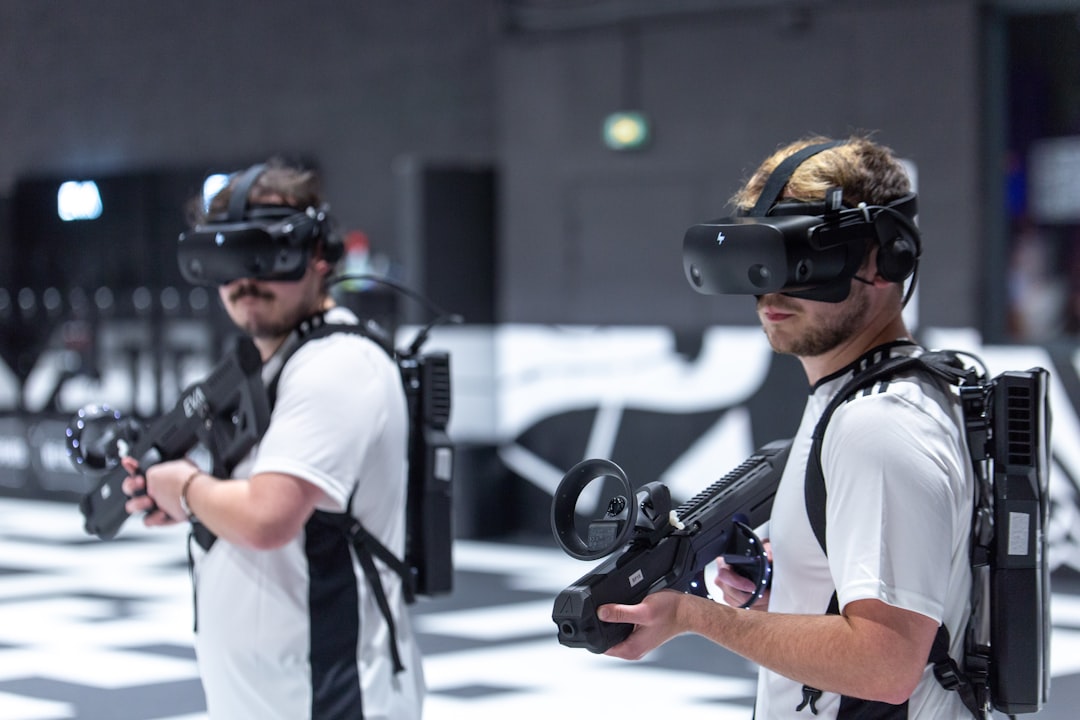Portals in the metaverse serve as gateways that connect disparate virtual environments, allowing users to traverse from one digital realm to another seamlessly. These portals can take various forms, ranging from simple hyperlinks to complex 3D structures that users can interact with. The concept of portals is not new; it has been a staple in science fiction and gaming for decades.
However, in the context of the metaverse, portals are evolving into sophisticated tools that facilitate exploration, social interaction, and commerce across multiple virtual spaces. The functionality of portals extends beyond mere transportation.
For instance, a portal leading to a fantasy realm might be adorned with mystical symbols and animations, enhancing the user’s sense of immersion. Conversely, a portal linking to a corporate environment may feature sleek, modern aesthetics that reflect professionalism. This adaptability makes portals not just functional but also integral to the narrative and thematic coherence of the metaverse.
Key Takeaways
- Portals in the Metaverse are digital gateways that allow users to move between different virtual environments and experiences.
- Navigating through portals requires users to interact with them using virtual reality devices or other digital interfaces.
- Portals play a crucial role in the Metaverse economy by facilitating transactions, interactions, and experiences within virtual environments.
- Creating and designing portals involves a combination of technical skills, creativity, and an understanding of user experience and interface design principles.
- The future of portals in the Metaverse holds potential for enhanced virtual reality experiences, interconnected virtual worlds, and new opportunities for social interaction and economic activity.
Navigating through portals involves more than just clicking a button or stepping through a threshold; it encompasses an entire experience that can vary significantly depending on the design and purpose of the portal. Users may encounter different interfaces or interaction methods when approaching a portal, such as voice commands, gesture controls, or traditional mouse clicks. The user experience is paramount; thus, developers must consider how intuitive and engaging the navigation process is to ensure that users feel comfortable exploring new environments.
Moreover, the journey through a portal can be enhanced with transitional effects that create a sense of wonder and anticipation. For example, as users approach a portal, they might witness visual distortions or hear ambient sounds that signal an impending transition. This sensory feedback not only heightens engagement but also prepares users for the shift in context they are about to experience.
The design of these transitions can significantly impact user satisfaction and their willingness to explore further within the metaverse.
The Role of Portals in the Metaverse Economy

Portals play a crucial role in shaping the economic landscape of the metaverse by facilitating commerce and trade between different virtual worlds. They enable businesses to reach broader audiences by connecting their offerings with users from various environments. For instance, a virtual clothing store in one world can create a portal that leads to a fashion show in another, allowing users to purchase exclusive items directly from the event.
This interconnectedness fosters a dynamic marketplace where goods and services can flow freely across boundaries. Additionally, portals can serve as platforms for advertising and promotional activities. Brands can strategically place portals in high-traffic areas within popular virtual worlds, directing users to special events or limited-time offers in other locations.
This not only enhances visibility but also encourages cross-platform engagement, where users are incentivized to explore new spaces and experiences. As the metaverse continues to grow, the economic implications of portals will likely expand, leading to innovative business models and revenue streams.
Creating and Designing Portals
| Metrics | Data |
|---|---|
| Number of Portals Created | 25 |
| Portal Design Satisfaction Rate | 90% |
| Time Taken to Create a Portal | 2 hours |
| Number of User Feedback | 50 |
The creation and design of portals require a blend of technical expertise and creative vision. Developers must consider various factors, including user interface design, aesthetic appeal, and functional requirements. The technical aspects involve programming the portal’s behavior, ensuring it responds correctly to user interactions and integrates seamlessly with other systems within the metaverse.
This may include backend considerations such as server load balancing and data management to ensure smooth transitions between worlds. On the creative side, designers must craft portals that resonate with the themes and narratives of both the originating and destination environments. This could involve using color schemes, textures, and motifs that reflect the unique characteristics of each world.
For example, a portal connecting a serene nature environment with a bustling urban landscape might incorporate elements from both settings—lush greenery intertwined with sleek metallic structures—to create a cohesive visual experience. The goal is to make each portal not just a functional element but also an artistic statement that enhances the overall immersion of the metaverse.
The Future of Portals in the Metaverse
As technology advances, the future of portals in the metaverse promises to be even more exciting and complex. With developments in augmented reality (AR) and virtual reality (VR), portals may evolve into multi-sensory experiences that engage users on multiple levels. Imagine stepping through a portal that not only transports you visually but also immerses you in soundscapes and tactile feedback that correspond to your new environment.
Such advancements could redefine how users perceive transitions between worlds, making them feel more like journeys rather than mere changes in scenery. Furthermore, artificial intelligence (AI) could play a significant role in personalizing portal experiences. AI algorithms could analyze user preferences and behaviors to tailor portal interactions uniquely for each individual.
For instance, if a user frequently visits art galleries within the metaverse, an AI-driven portal could suggest new exhibitions or artists based on their interests as they approach it. This level of personalization would enhance user engagement and satisfaction while encouraging exploration within the vast expanse of interconnected virtual worlds.
Portals and Virtual Reality Experiences

Incorporating portals into virtual reality experiences adds an additional layer of immersion that traditional interfaces cannot replicate. When users don VR headsets, they are transported into fully realized 3D environments where their physical movements translate into digital actions. Portals within these spaces can create a sense of physicality; users can reach out and touch them or walk through them as if they were real objects in their environment.
This tactile interaction enhances the feeling of presence, making users more invested in their virtual journeys. Moreover, VR portals can facilitate social interactions by allowing users to meet friends or collaborators in different virtual spaces without losing the immersive quality of their experience. For example, a group of friends could gather in a shared VR space before stepping through a portal together to attend a concert or explore an art installation.
This shared experience fosters community building within the metaverse while maintaining the excitement of discovery that comes with navigating through portals.
Portals and Interconnected Virtual Worlds
The concept of interconnected virtual worlds is central to the vision of the metaverse as an expansive digital universe where users can traverse seamlessly between diverse environments. Portals act as vital links in this network, enabling users to explore various realms without feeling confined to a single space. This interconnectedness allows for rich storytelling opportunities; narratives can unfold across multiple worlds, encouraging users to piece together clues or experiences from different locations.
Additionally, interconnected worlds facilitated by portals can lead to collaborative projects that span various domains. For instance, artists from different backgrounds could create a joint exhibition that showcases their work across multiple virtual galleries linked by portals. This collaboration not only enriches the artistic landscape but also promotes cultural exchange among users from different parts of the globe.
As more creators embrace this interconnected model, we may witness an explosion of creativity and innovation within the metaverse.
Ethical and Security Considerations in Portals Exploration
As with any rapidly evolving technology, ethical and security considerations surrounding portals in the metaverse are paramount. One significant concern is user privacy; as individuals navigate through various portals, their data may be collected and analyzed by different platforms. Ensuring that users have control over their information and understand how it is being used is essential for fostering trust within these digital spaces.
Moreover, security risks associated with portals cannot be overlooked. Malicious actors may exploit vulnerabilities in portal systems to gain unauthorized access to user accounts or sensitive information. Developers must prioritize robust security measures when designing portals, including encryption protocols and regular security audits.
Additionally, educating users about safe practices while navigating through portals—such as recognizing phishing attempts or avoiding suspicious links—can help mitigate potential risks. In conclusion, while portals offer exciting opportunities for exploration and interaction within the metaverse, addressing ethical and security concerns is crucial for creating a safe and enjoyable experience for all users. As technology continues to advance, striking a balance between innovation and responsibility will be key to realizing the full potential of portals in this expansive digital landscape.
If you’re interested in learning more about the potential for tourism in the metaverse, be sure to check out this article on tourism in the metaverse. It explores the opportunities and challenges of creating virtual travel experiences within this digital realm. Additionally, for insights into community and culture in the metaverse, you can read about user-generated content in the metaverse here. And if you’re curious about gaming platforms and ecosystems in the metaverse, be sure to check out this article on gaming in the metaverse here. These resources provide valuable insights into the diverse possibilities and experiences that the metaverse has to offer.
FAQs
What is a portal in the metaverse?
A portal in the metaverse is a digital gateway that allows users to access different virtual environments, experiences, or locations within the metaverse. It serves as a means of navigation and transportation between different areas of the virtual world.
How do portals work in the metaverse?
Portals in the metaverse typically function as interactive elements within virtual environments. Users can interact with a portal to enter a new virtual space, teleport to a different location, or access specific content within the metaverse.
What are the uses of portals in the metaverse?
Portals in the metaverse have various uses, including facilitating virtual travel between different locations, connecting users to specific experiences or events, and providing a seamless way to navigate the virtual world.
Are portals in the metaverse similar to portals in video games?
Portals in the metaverse share similarities with portals in video games, as both serve as gateways to access new areas or levels. However, portals in the metaverse are often designed to connect users to a broader range of virtual experiences and environments beyond traditional gaming contexts.
Can portals in the metaverse be customized or created by users?
In some metaverse platforms, users have the ability to create and customize their own portals, allowing them to design unique entry points to their virtual spaces or experiences. This customization adds a layer of personalization and creativity to the metaverse environment.

Leave a Reply